
Ichneutica lissoxyla is a moth of the family Noctuidae. It is endemic to New Zealand. It is found in the central and southern parts of the North Island and in most parts of the South Island. The species prefers snowgrass habitat in the alpine zone. I. lissoxyla is similar in appearance to I. paraxysta but can be distinguished as I. lissoxyla lack the black streaks on the forewings that can be found on the latter species and the male I. lissoxyla also has longer pectinations on antennae. The life history of this species is unknown as are the host species of its larvae. Adults are on the wing from January to April and are attracted to the light.

Ichneutica petrograpta is a moth of the family Noctuidae. This species is endemic to New Zealand where it is found in the southwest districts of the South Island, including Westland, Otago Lakes and Fiordland. It is very similar in appearance to I. mutans. It inhabits tussock and shrubland in the alpine to subalpine zones. Adults of I. petrograpta are on the wing from December to February and are attracted to sugar traps. The life history of this species is unknown as are the host species of its larvae.

Ichneutica arotis is a moth of the family Noctuidae. It is endemic to New Zealand. This species is found throughout the North and South Islands but has yet to be recorded on Stewart Island. I. arotis is variable in appearance and have been described as having a "northern dark form", a "typical" form and a "swamp" form. Robert Hoare hypothesised that this species may be in the process of evolving into several distinct species. However, as these forms show no difference in antennae or genitalia so, as at 2019, they are not regarded as separate species. Larval hosts include species in the genera Cortaderia and Schoenus as well as Phormium tenax. The caterpillar feeds at night and rests in during the day amongst dead flax leaves. It pupates in a loose cocoon either hidden at the base of a stem of flax or on the ground. The adults of this species is on the wing from September to April. In the North Island there have also been records of adults being on the wing in June to August.
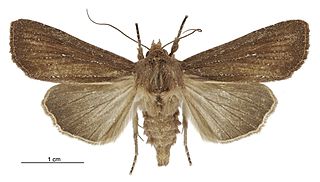
Ichneutica micrastra is a moth of the family Noctuidae. It is endemic to New Zealand. This species has been found only in the North Island and has been collected in the Northland, Auckland, Whanganui and Wellington regions. The preferred habitat of this species is wetlands and heathlands including gum fields in Northland. Adults of this species are on the wing from October to December. The life history of this species is unknown as are the host species of its larvae however it has been hypothesised that the likely larval host is a grass or grass like plant. This species is very similar in appearance to I. phaula and I. sapiens but can be distinguished as a result of differences in male antennae, the shape, colour and size of forewings, the range of the species as well as differences in genital shape.
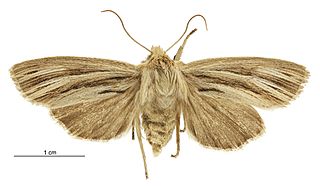
Ichneutica stulta is a moth of the family Noctuidae. It is endemic to New Zealand. This species has only been collected from West Plains and Tuturau in Southland but, as at 2021, no male species appears to exist in collections. I. stulta can resemble I. acontistis but can be distinguished as I. stulta has a strongly curved forewing edge as well as having a discal spot on the underside of the hindwing. I. stulta is also darker than specimens of I. acontistis obtained in the southern parts of the South Island. I. stulta is also very similar in appearance to I. emmersonorum but the later species has darker forewings and is more strongly marked on the thorax. The life history of this species is unknown as are the host species of the larvae but the adults have been recorded as being on the wing from October to December.

Ichneutica steropastis, or the flax notcher moth, is a species of moth in the family Noctuidae. It is endemic to New Zealand and can be found throughout the country from the Three Kings Islands to Stewart Island as well as in the Chatham Islands. The larvae of this species feed on a variety of native and introduced plants however the New Zealand flax is one of the more well known host plants for the larvae of this moth. The larvae are nocturnal, hiding away in the base of the plants and coming out to feed at night. They create a distinctive notch in the leaf when they feed. The adults of this species are on the wing from October to March. Although adult specimens of I. steropastis are relatively easy to recognise they might possibly be confused with I. inscripta, I. theobroma or with darker forms of I. arotis. However I. steropastis can be distinguished as it has a long dark basal forewing streak that these three species lack.

Ichneutica erebia is a moth of the family Noctuidae. This species is endemic to New Zealand and is found on Campbell Island and the Auckland Islands. Adults of this species are on the wing from August to January. The adults are variable in appearance but can be distinguished from similar species by the patters or lack thereof on their forewings. The larvae of I. erebia are polyphagous and hosts include Pleurophyllum criniferum, species within the genera Stilbocarpa and Carex, as well as Chionochloa antarctica, Urtica australis and Raukaua simplex.
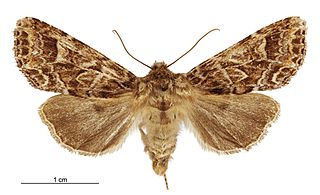
Ichneutica brunneosa is a moth of the family Noctuidae. This species is endemic to New Zealand. It can be found in the North Island from Mount Te Aroha and in the South Island from the Coromandel to Stewart Island. However it appears to not be present in the centre of the South Island. The distinctive colour and patterns on the forewing of this species ensures it is unlikely to be confused with similar species. It inhabits native forests with higher rainfall and is attracted to mercury vapour light traps. The life history of I. brunneosa is unknown as are the host species of its larvae but the adults of the species are on the wing from October to January.
Ichneutica dundastica is a moth of the family Noctuidae. This species is endemic to New Zealand. As at 2019 this species has only been found near the Dundas Hut in the Tararua Range near Wellington. It inhabits alpine shrubland and is attracted to light. The life history of this species is unknown as are the host species of its larvae however adults are on the wing from late November to early December. The female of the species is larger and more conspicuous than the male.
Ichneutica naufraga is a moth of the family Noctuidae. This species is endemic to New Zealand. It is only found on Big South Cape Island. The host of I. naufraga larvae is Poa foliosa, upon which the larvae feed at night. Adult moths have been recorded on the wing in November. This species can be distinguished from the visually similar I. mutans as both the male and female of the former species lack the distinctive dark marking that can be found on the forewings of I. mutans. The female I. naufraga is coloured a brown shade as opposed to the grey I. mutans and the male I. naufraga has longer antenna pectinations.
Ichneutica peridotea is a moth of the family Noctuidae. This species is endemic to New Zealand. The species is similar in appearance to Ichneutica plena but are more dull olive-green in appearance and the male lacks the patches of orange-brown forewing scales of the male I. plena. As at 2021 I. peridotera has only been collected in the Auckland District although Robert Hoare hypothesises that its range may include the northern districts of the North Island. The lack of information about this species is partially due to the fact it is late winter flying. The life history of this species is unknown as are the hosts of its larvae. Its preferred habitat is forest and the adults are attracted to light.
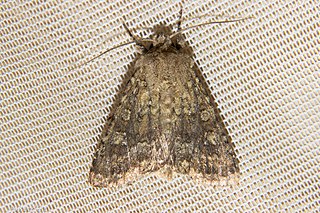
Ichneutica barbara is a moth of the family Noctuidae. This species is endemic to New Zealand and is only found in the South Island, more commonly on the eastern side of the South Island. This species has a grey forewing and is visually very similar in appearance to its close relative I. omicron. However the adult male of I. barbara has a yellow anal tuft in comparison to the grey tuft of I. omicron. In collections I. barbara has sometimes been confused with I. sistens. I. barbara appears to inhabit shrubland localities. The life history of this species is unknown as are the host species of the larvae but adults are on the wing from October to December.
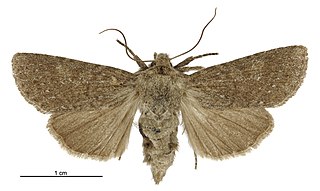
Ichneutica sollennis is a moth of the family Noctuidae. This species is endemic to New Zealand. This species is known from the eastern and central areas of the southern South Island. It inhabits alpine zones and has been collected in tussock grasslands. The life history of this species is unknown. Although the host species is currently unknown it has been hypothesised that this species have grass or grass like plants as host plants. Adults are on the wing from November to February and are attracted to light.
Ichneutica cornuta is a moth of the family Noctuidae. This species is endemic to New Zealand and is only found in the South Island, in and around the Southern Alps. I. cornuta is very similar in appearance to pale forms of I. arotis. It is easy to confuse the two species as their ranges overlap. Male I. cornuta can be distinguished as it has longer pectinations on the antennae and the female lacks the dark scaling that can be found on the thorax of the I. arotis. There are also subtle differences in the forewing patterns of the two species. The life history of this species is unknown as are the host species of its larvae. Adults are on the wing from January to April.
Ichneutica sapiens is a moth of the family Noctuidae. This species is endemic to New Zealand. I. sapiens is found in the central North Island, in the South Island in Westland and also the southern parts of the South Island, and in Stewart Island. This species inhabits wetland habitat but its life history is unknown as are the host species of its larvae. The adult moths are on the wing between December and early January and are attracted to sugar traps and to light. I. sapiens is very similar in appearance to I. micrastra but is a smaller moth with a shorter wingspan, has differently formed antennae and slightly different forewing markings.
Ichneutica haedifrontella is a moth of the family Noctuidae. This species is endemic to New Zealand. It is only known from scattered areas in the North and South Islands. In the North Island it has only been collected in the Pouakai Range in Taranaki. In the South Island it is known from the Nelson, Buller, North Canterbury, Otago Lakes and Fiordland regions. It inhabits alpine to subalpine zones. The life history of this species is unknown as are the host species of its larvae in the wild. Larvae have been reared on species in the Chionochloa genus. Adults are on the wing from December to February and are attracted to light. This species has a smaller dwarf form that can be found in the Pouakai Range and at Dart Hut.
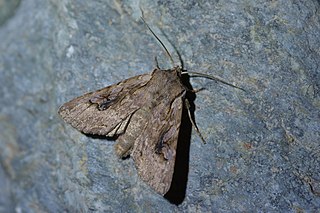
Ichneutica lindsayorum is a moth of the family Noctuidae. This species is endemic to New Zealand and can be found in the southern parts of the North Island and in the South Island. I. lindsayorum is very similar in appearance to I. olivea but has a longer basal streak and lacks the white scaling from the subterminal line on the forewing that can be found on the forewings of I. olivea. The life history of this species is unknown as are the host species of its larvae in the wild. However larvae have been reared on Ozothamnus leptophyllus. The adults of this species are on the wing from December to April.
Ichneutica supersulcana is a moth of the family Noctuidae. This species is endemic to New Zealand and is only known from the Tararua Ranges and at Tongariro National Park. This species has been collected in subalpine tussock grasslands as well as subalpine shrubland and at the margins of Fuscospora cliffortioides forest. The life history of this species is unknown as are the host species of its larvae. The adults of this species are on the wing in February and are attracted to light. It appears to be restricted to higher altitudes in comparison to its close relative I. sulcana.I. sulcana and I. supersulcana are very similar in appearance with no reliable visible differences between the two having been discovered. However, there are distinct differences in the male abdomen and genitalia of these two species.
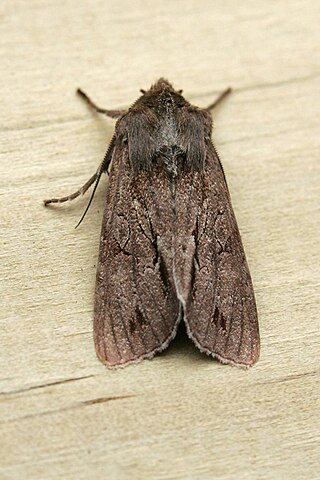
Ichneutica rufistriga is a moth of the family Noctuidae. This species is endemic to New Zealand and is only found in the Antipodes Islands. The larvae of I. rufistriga feed on various host species including Urtica australis and have been reared on Rumex obtusifolius, Stellaria media and Rheum rhabarbarum. It has been hypothesised the larvae might also feed on Austroblechnum durum. The larvae pupate in a cocoon buried in the soil. In captivity it took 12 weeks to raise a generation from egg to adult. Adults of this species have been recorded as being on the wing from October to February.
Ichneutica thalassarche is a moth of the family Noctuidae. This species is endemic to New Zealand and is only found in the Chatham Islands. It has been collected at Chatham Island, Pitt Island and Rangatira Island. The life history of this species is unknown as are the host species of its larvae. The adults of this species are large with a pale grey throax and forewing. A diagnostic feature is the pattern on its forewing which is a white subterminal line joined by black "teeth" markings. This species has been recorded as a winter flyer having been collected in June to August.












